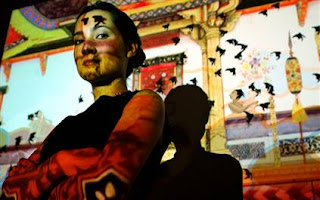Shahzia Sikander, born in Pakistan and now lives in New York. She has pushed the boundaries exploring her identity and challenging the idea of what it means to be a Muslim. Her goals behind the creation of her work is to change the current views and stereotypes of Muslim women in particular.
Known for her miniature paintings, she says in her Art21 interview, they are a form of manuscript painting and that it is an old art form. She also states that to create the miniature paintings they require at least 10 to 20 layers of colors and if too much water is on the brush, the layers previously painted may be lifted off. These miniature paintings play an important part of her culture and historical and religious tradition.
One of her most famous works, The Scroll, can be described as a semi-autobiographical work.
"She adopted the formal style of manuscript painting, with its broken and varied perspectives and simultaneous views of multiple events, to depict a family's intricate domestic life and rituals through images that manipulate cultural, familial, and geographic traditions." (Chadwick 445)Living in a home with a supportive family that encouraged her and the other women in the family to have a career. Which was somewhat atypical for Muslim women at the time, and still is. This theme of sexism along with the issues of displacement and identity is illustrated throughout her work and many other artists during the 20th century.
 |
| Who's Veiled Anyway? 1997 |
By using her memory, and experiences and incorporating them into her miniature paintings, it's almost like she is writing, or re-writing history when creating her works.
Sikander said, "The minute you bring the word veil into the equation, it connects you to a Muslim identity or a woman's identity."
One of her pieces titled, "Who's Veiled Anyway?," illustrated a man wearing a veil, which is the reverse in her religion where the female usually covers herself with a veil. The statement that she makes challenges the viewer to think for themselves, on whether the veil is on the figure in the painting or is it on those who are ignorant of her culture and history? Being from Pakistan and from the middle east, comes with a stereotype, especially after 9/11. This painting may have more meaning now than it did when it was first created.
In many of Sikander's works, images from the Hindu and Muslim religion are juxtaposed. Her personal experience of growing up as a Muslim in Pakistan, she states that she did not know much about the Hindu mythology but she was interested in it. By incorporating both religions into one picture plane, her piece, "Pleasure Pillars," does just that.
Depending on the context of which her pieces are viewed, the reactions she receives varies. When showing her work in the United States compared to Pakistan, Sikander says, "That work may be seen different in different situations."
She also states that her work in the mid-nineties dealt a lot with identity, because she herself became important to the viewers which also changed on how she dealt with her work, making art to create commentary on what was commented on.
Works Cited
Chadwick, Whitney. Women, Art, and Society. New York, NY: Thames and Hudson, 1990. Print.
http://www.massart.edu/About_MassArt/News/Shahzia_Sikander.html
http://www.moma.org/interactives/redstudio/interviews/shahzia/shahzia.html
http://www.pbs.org/art21/artists/shahzia-sikander



I like how you chose an artist that was not well-known and it shows that you did extensive research and provided a lot of great detail on Shahzia Sikander
ReplyDeletePicking an artist that is not a known was a great idea i wish i wouldve look into someon else rather than Frida but the research and the fact about her were really interesting and capture my attention right away
ReplyDelete